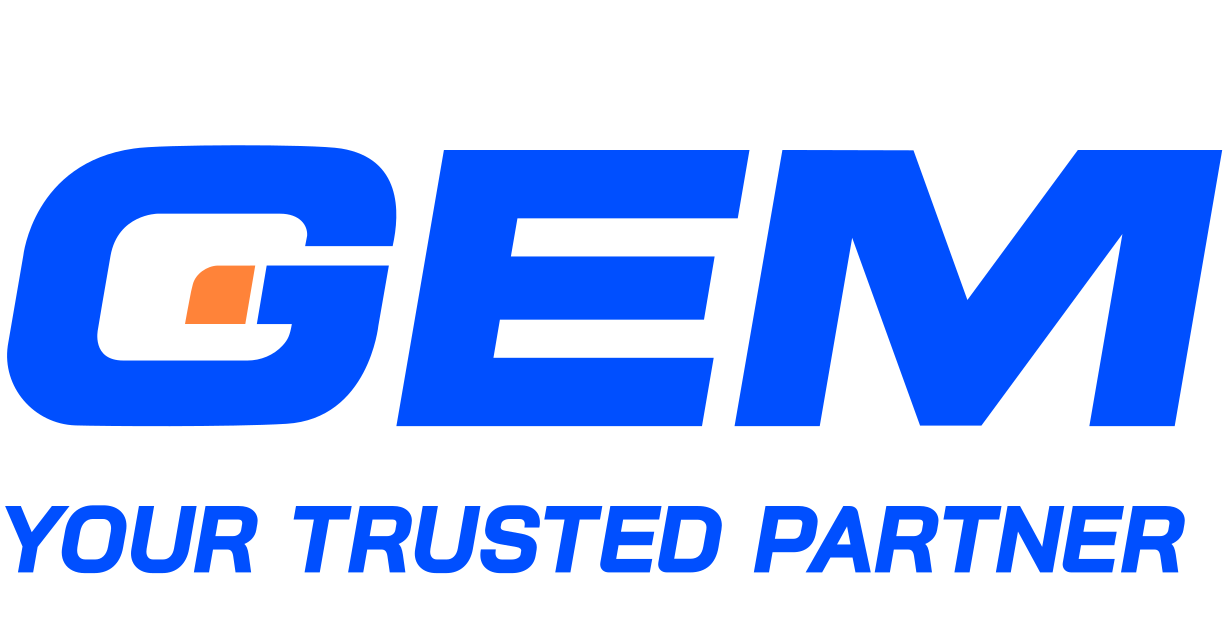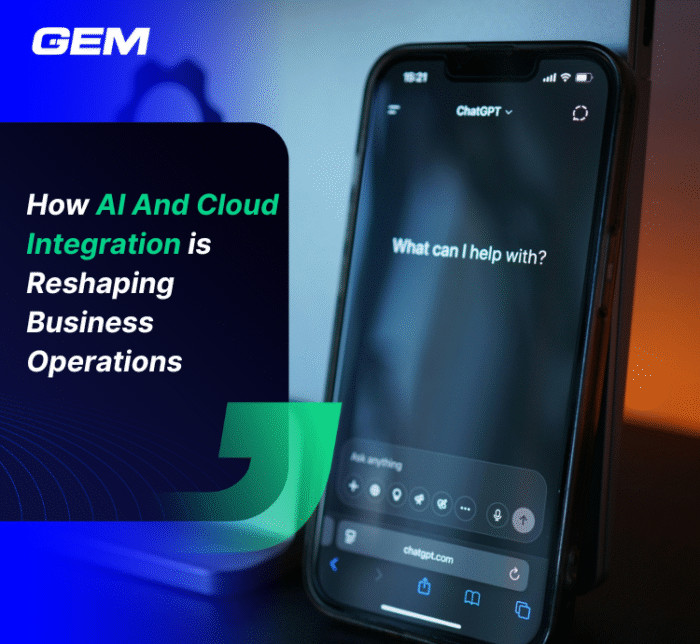Contents
- What is ServiceNow ITOM?
- What is ServiceNow ITSM?
- ServiceNow ITOM vs ITSM: Key Differences
- When to Use ServiceNow ITOM and ITSM?
- ServiceNow ITOM vs ITSM: The Benefits of Combining Solutions
- How to Implement ServiceNow Modules?
- Implementing ServiceNow Solutions with GEM Corporation
- Conclusion
- What is the role of ServiceNow ITOM in enterprise environments?
- How does ServiceNow ITSM differ in scope and function?
- What are the key differences between ITOM and ITSM in the ServiceNow ecosystem?
- When should an organization use ITOM vs. ITSM?
- What are the benefits of combining ServiceNow ITOM and ITSM, and how should implementation be approached?
As enterprises scale their digital operations, understanding the difference between ITOM vs ITSM in ServiceNow becomes more important. While both are part of the same platform, they solve distinct challenges – one focused on delivering IT services, the other on managing the infrastructure that powers them. According to Gartner, over 70% of organizations are now expanding IT operations to support hybrid environments, making it harder to draw clear lines without the right context. This article breaks down what each function does, where they overlap, and how to decide which one, or both, fits your organization’s needs. Let’s look at each in detail.
What is ServiceNow ITOM?
The IT operations management market is valued at USD 36.3 billion in 2025 and is forecast to reach USD 64.9 billion by 2030, expanding at a 12.30% CAGR (Mordor Intelligence).
ServiceNow IT Operations Management (ITOM) is designed to monitor, manage, and optimize the IT infrastructure that underpins enterprise digital services. It provides the operational backbone for organizations aiming to maintain service health, reduce outages, and gain full-stack visibility across hybrid IT environments, from on-premises to multicloud.
Core Functions and How ITOM Works
- Discovery
- Automatically identifies IT assets and their relationships across hybrid environments.
- Updates the Configuration Management Database (CMDB) in real time.
- Supports scheduled and on-demand discovery of infrastructure, cloud services (IaaS, PaaS, CaaS), and containerized workloads.
- Service Mapping
- Maps application services to the underlying infrastructure dynamically.
- Helps teams understand service dependencies and assess the impact of changes or incidents.
- Enables service-aware operations by linking technical components to business services.
- Event Management
- Collects and correlates events from multiple monitoring tools.
- Uses AI to suppress noise, identify patterns, and detect root causes.
- Provides a unified view of operational health via the Service Operations Workspace.
- Metric Intelligence
- Continuously analyzes performance metrics to spot trends and anomalies.
- Supports proactive identification of service degradation before it affects users.
- Enables integration with AIOps for predictive analysis.
- Health Log Analytics
- Ingests and analyzes log data in real time.
- Detects anomalies using machine learning, helping teams resolve issues faster.
- Improves service resilience by surfacing critical signals early in the incident lifecycle.
- Cloud Accelerate
- Automates provisioning and lifecycle management of cloud infrastructure.
- Ensures governance across hybrid and multicloud environments.
- Supports visibility into AWS, Azure, GCP, and Kubernetes deployments.
- Certificate Management
- Discovers and tracks TLS/SSL certificates across environments.
- Provides alerts before expiration and automates renewal workflows.
- Firewall Audits and Reporting
- Tracks firewall configurations and audit trails.
- Centralizes policy enforcement and compliance reporting.
- Synthetic Monitoring
- Simulates user interactions to test availability and performance of critical services.
- Provides 24/7 monitoring coverage with proactive alerting.
- Agent Client Collector (ACC)
- Collects metrics and telemetry data from servers and endpoints.
- Enables custom monitoring checks and supports community-driven extensions.
- Service Graph Connectors
- Integrates third-party data sources into the ServiceNow CMDB.
- Maintains data consistency across operational tools and systems.
Typical Use Cases
- Detecting server anomalies using predictive AIOps and log analytics to analyze telemetry data and identify deviations before user impact occurs.
- Automating system patches and remediations by linking known alerts to pre-built workflows that resolve issues without manual intervention.
- Scaling cloud infrastructure dynamically, based on real-time usage and cost optimization policies, to support demand-driven service delivery.
Modular Packages
ServiceNow offers ITOM in scalable packages:
- ITOM Visibility: Includes Discovery, Service Mapping, CMDB, and foundational visibility tools.
- ITOM AIOps Professional: Adds Event Management, Metric Intelligence, and reliability management.
- ITOM AIOps Enterprise: Extends capabilities with Health Log Analytics, Cloud Accelerate, Synthetic Monitoring, and advanced observability.
Read more: Discover What ServiceNow ITOM Is and How It Can Optimize Your IT Operations for Maximum Efficiency.
What is ServiceNow ITSM?
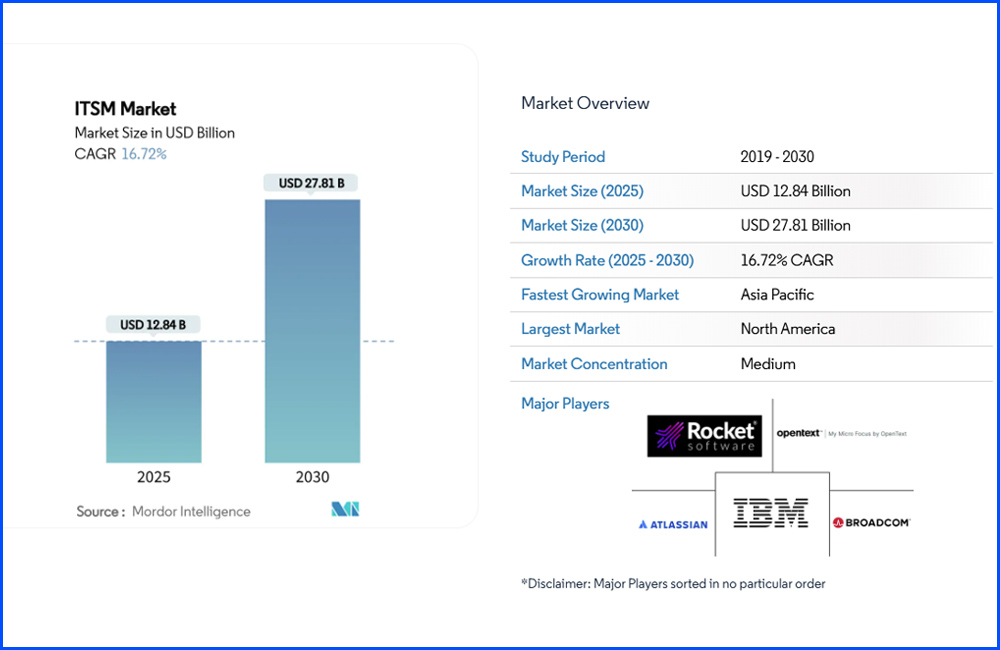
The IT service management market was valued at USD 12.84 billion in 2025 and is projected to grow to USD 27.81 billion by 2030, reflecting a compound annual growth rate (CAGR) of 16.72%.
ServiceNow IT Service Management (ITSM) is a cloud-based solution that helps organizations deliver efficient, scalable, and consistent IT services. Built on the Now Platform, it brings together AI, automation, and best-practice workflows to streamline service delivery, reduce operational cost, and improve user experience. It aligns with ITIL standards and supports both traditional IT operations and modern digital service environments.
Core Functions and How ITSM Works
- Incident Management
- Routes and prioritizes issues using AI-based recommendations.
- Provides a central workspace for service agents to track, escalate, and resolve incidents.
- Integrates with Virtual Agent and predictive intelligence to reduce resolution time.
- Problem Management
- Identifies and addresses root causes of recurring incidents.
- Supports trend analysis and post-incident reviews to reduce future disruptions.
- Linked to known error databases and the configuration management database (CMDB).
- Change Management
- Automates change request approvals using policy-based workflows.
- Integrates with DevOps pipelines to balance speed and control.
- Assesses risk and impact with help from service-aware CMDB insights.
- Request Management
- Offers a unified service catalog for employees to request IT services, software, or hardware.
- Supports automated fulfillment and approval routing.
- Accessible via web portal, mobile app, and Virtual Agent.
- Service Level Management
- Tracks and enforces SLAs through real-time dashboards and alerts.
- Provides visibility into service performance and breach risks.
- Helps align IT services with business expectations and commitments.
- Knowledge Management
- Creates a centralized knowledge base with searchable, reusable content.
- Supports guided resolution and self-service.
- Built-in machine learning helps surface relevant articles to agents and users.
- Configuration Management Database (CMDB)
- Maintains a comprehensive inventory of IT assets and their relationships.
- Powers impact analysis during incidents, changes, and outages.
- Enhances visibility and governance across IT services.
- Virtual Agent and Now Assist
- Delivers AI-powered chat interfaces for employees to resolve issues or make requests.
- Integrates with backend workflows for real-time fulfillment.
- Uses natural language understanding (NLU) to handle common inquiries.
- Performance Analytics
- Provides real-time and historical analytics on service performance.
- Offers out-of-the-box KPIs aligned with ITIL processes.
- Supports continuous improvement with actionable insights.
Typical Use Cases
- Resolving user-reported issues through an omnichannel support interface, AI-powered triaging, and SLA-based workflows.
- Managing service requests such as access provisioning, hardware delivery, or software installation via a digital storefront.
- Ensuring SLA compliance by tracking incident resolution times, monitoring service queues, and identifying bottlenecks.
- Automating approvals and fulfillment for high-volume, repeatable tasks like onboarding new employees or resetting passwords.
- Supporting change governance across IT and DevOps with automated workflows for risk assessment, testing, and deployment.
Modular Packages
ServiceNow ITSM is available in three tiers to match organizational needs:
- ITSM Standard: Includes core capabilities such as Incident, Problem, Change, and Request Management, along with CMDB and Service Operations Workspace.
- ITSM Pro: Adds AI-driven features like Predictive Intelligence, Virtual Agent, Performance Analytics, and Continual Improvement Management.
- ITSM Enterprise: Extends to Process Mining, Workforce Optimization, and advanced automation for large-scale IT environments.
Read more: Explore the Top ServiceNow Modules and Learn How They Can Transform Your IT and Business Workflows
ServiceNow ITOM vs ITSM: Key Differences
While both ServiceNow ITSM and ITOM operate on the same platform and often work together, they address different parts of the IT landscape. Understanding how they differ helps teams align tools, responsibilities, and outcomes more effectively.
Primary Focus
- ITOM is designed to monitor and manage the infrastructure that powers digital services. It handles the systems, cloud platforms, and applications that must perform reliably at scale.
- ITSM focuses on the delivery and support of IT services to end users. It manages processes like issue resolution, request fulfillment, and service-level tracking.
Key Stakeholders
- ITOM is primarily used by infrastructure operations teams, platform owners, and site reliability engineers. They work behind the scenes to maintain uptime and automate remediation.
- ITSM is used by service desk agents, IT support teams, and end users who interact directly with service management workflows.
Core Modules
- ITOM includes Discovery, Event Management, Service Mapping, Metric Intelligence, and Health Log Analytics. These modules provide full-stack visibility, monitor service health, and automate operational tasks.
- ITSM includes Incident Management, Change Management, Request Management, and Service Level Management. These modules help manage service tickets, approvals, and user interactions.
Business Objectives
- ITOM aims to improve system stability, reduce operational noise, and drive efficiency through automation.
- ITSM focuses on service quality, faster issue resolution, and better user experience.
Data Dependency
- ITOM relies on telemetry such as logs, performance metrics, discovery data, and system events. It processes machine data to understand infrastructure behavior.
- ITSM relies on user reports, structured service data, and workflow records. It manages data tied to human interactions.
Summary table
| Category | ITOM | ITSM |
| Primary Focus | Infrastructure & operations | Service delivery & support |
| Key Stakeholders | Ops teams, platform owners | Service desk, end users |
| Core Modules | Discovery, Event Management, CMDB | Incident, Change, Request |
| Business Objective | System stability, efficiency | Service quality, user experience |
| Data Dependency | Performance metrics, logs | Service data, user reports |
Understanding where ITOM ends and ITSM begins helps organizations design better workflows, align team responsibilities, and prioritize their ServiceNow investment based on operational maturity.
When to Use ServiceNow ITOM and ITSM?
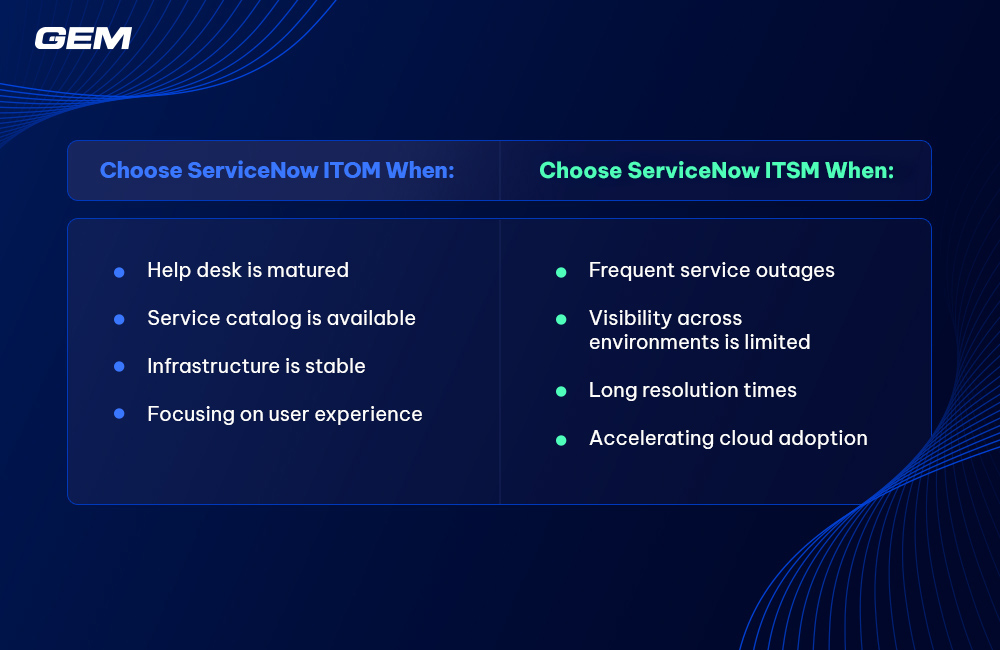
Organizations often start with ITSM to establish consistent service delivery, then adopt ITOM as infrastructure complexity grows. While both systems address different operational needs, knowing when to deploy one over the other, or both, depends on business maturity, operational challenges, and IT footprint.
Scenarios Where ITSM Is Sufficient
ServiceNow ITSM is typically enough when:
- The help desk is mature and structured around repeatable processes
Teams are already managing incidents, service requests, and changes through defined workflows.
- Service delivery is driven by a service catalog
Employees can request apps, hardware, or access through a self-service portal, and fulfillment follows automated or semi-automated paths.
- Incident volumes are predictable and infrastructure is relatively stable
There’s limited need for real-time telemetry or automated root-cause analysis.
- IT is more focused on user experience than infrastructure performance
The business may not yet require full-stack observability or automated remediation.
Indicators ITOM Is Needed
ITOM becomes necessary when operational maturity demands deeper infrastructure control:
- Frequent or unexplained service outages
Without real-time monitoring and event correlation, teams struggle to identify root causes.
- Limited visibility across hybrid or multicloud environments
As infrastructure spans multiple vendors and platforms, the need for unified discovery and service mapping grows.
- Reactive operations lead to long resolution times
Teams are overwhelmed by alerts and lack automated triage or remediation mechanisms. Configuration drift and compliance gaps. Without a reliable CMDB or monitoring tools, infrastructure changes introduce risk.
- Cloud adoption accelerates
With more dynamic workloads and ephemeral resources, infrastructure management requires automation and continuous governance.
Influence of Organization Size, Complexity, and Cloud Adoption
| Factor | Influence on Choice |
| Small to midsize business | ITSM is often the starting point, with a focus on ticketing and service delivery. |
| Enterprise-scale environment | ITOM becomes critical to manage distributed infrastructure, reduce MTTR, and maintain uptime. |
| High cloud dependency | ITOM tools like Cloud Accelerate and Service Mapping help govern dynamic workloads and reduce service risk. |
| Complex IT landscape | Combining ITSM and ITOM supports coordination between user-facing teams and infrastructure operations. |
Stop trying to find the dots. Let us help you connect them!
ServiceNow ITOM vs ITSM: The Benefits of Combining Solutions
Operational silos between infrastructure and service delivery teams often result in blind spots, inefficiencies, and delayed response to incidents. Integrating ITOM and ITSM addresses these gaps with a connected operational model.
Reduction in Mean Time to Resolution (MTTR)
By correlating service incidents with infrastructure events, teams isolate root causes faster, cutting resolution times by 30–50%, based on industry benchmarks.
Avoiding downtime with proactive automation
Automated remediation flows triggered by ITOM can resolve known issues before users are impacted, improving uptime and reducing ticket volumes.
Faster onboarding of cloud services
Discovery and Service Mapping support dynamic environments, enabling scalable delivery of cloud-based services through existing ITSM channels.
Improved SLA compliance
Unified monitoring and service response help meet service-level targets more consistently by reducing delays and manual handoffs.
How to Implement ServiceNow Modules?
Rolling out ServiceNow modules means an operational redesign that requires careful sequencing, stakeholder alignment, and data integrity. A structured approach is key to unlocking long-term platform value and avoiding missteps that can stall adoption or inflate costs.
How to Approach Integration?
1. Build on Foundational Capabilities: Start with the CMDB
A reliable Configuration Management Database (CMDB) underpins every ServiceNow workflow, whether it’s automation in ITOM or request routing in ITSM. The integration effort should begin with:
- Defining the CI model and service hierarchy: Start with core infrastructure, applications, and business services. Make sure these align with what ITSM and ITOM teams need to see.
- Automating data ingestion: Use ServiceNow Discovery and third-party integrations (e.g., cloud providers, network monitoring tools) to populate the CMDB continuously rather than manually.
- Establishing ownership and update policies: Assign responsibility for maintaining CI accuracy, and implement reconciliation rules to avoid conflicts between sources of truth.
2. Align Stakeholders Across IT Operations and Service Management
Integration fails when roles, expectations, and workflows are designed in silos. Early alignment between ITSM and ITOM stakeholders is a prerequisite. This includes:
- Joint planning and scoping: Define what “integration” looks like across teams. For instance, how Event Management will trigger Incident Management or how changes flagged by ITOM will flow into ITSM change requests.
- Cross-functional governance: Establish a shared steering group with representation from infrastructure, service delivery, compliance, and platform teams to oversee priorities, platform usage, and release cycles.
- Unified metrics and dashboards: Agree on a shared set of KPIs (e.g., MTTR, SLA compliance, change success rate) and build reporting views that both teams can use to assess performance and spot gaps.
3. Prioritize High-Impact Use Cases First
Avoid trying to do everything at once. Focus on use cases that offer operational leverage and measurable ROI. Examples include:
- Event-to-Incident Automation: Configure Event Management so that alerts from monitoring tools generate incidents automatically, complete with CI context, impact analysis, and suggested resolution paths.
- Change Risk Prediction: Use data from past incidents and CMDB relationships to assign risk scores to change requests. This shortens approval cycles and reduces the likelihood of service disruption.
- Automated Remediation: Link common infrastructure issues (e.g., server restarts, service restarts) to pre-defined remediation workflows that trigger directly from detected anomalies.
- Outage Impact Analysis: Use Service Mapping to quickly assess which services and users are affected by infrastructure issues, improving communication and reducing false escalations.
Why You Need a Certified ServiceNow Partner
This is where a specialized ServiceNow partner becomes indispensable. Expertise is needed across:
- Platform architecture and module interoperability
- CMDB modeling and discovery strategy
- Workflow orchestration across ITOM and ITSM
- Change management and adoption planning
Implementing ServiceNow Solutions with GEM Corporation
GEM Corporation is a global IT solutions provider helping enterprises turn complex challenges into growth-ready digital systems. With a global presence and strategic delivery centers in Vietnam, we bring together robust engineering capabilities, industry-specific knowledge, and a commitment to long-term impact.
As a certified ServiceNow partner, GEM delivers full-cycle consulting, implementation, and managed services tailored to enterprise needs. Our approach focuses on building ServiceNow environments that scale with the business, whether through ITSM, ITOM, or cross-functional workflows. We specialize in aligning ServiceNow capabilities with organizational objectives, from CMDB architecture and Discovery to Service Mapping, Event Management, and automated incident resolution. With a team of certified ServiceNow professionals and domain specialists, we address integration complexity, accelerate platform adoption, and design automation strategies that deliver measurable ROI.
Conclusion
ITOM vs ITSM in ServiceNow is a strategic decision about how organizations manage services and operations. ITSM brings structure to service delivery, while ITOM adds the intelligence and automation needed to manage dynamic infrastructure. When integrated, they close visibility gaps, streamline workflows, and support faster, data-driven decisions. The key lies in a strong CMDB, stakeholder alignment, and prioritizing high-impact use cases.
To explore how this integration can advance your operations, contact GEM’s ServiceNow team!
How does ServiceNow ITSM differ in scope and function?
ServiceNow ITSM (IT Service Management) focuses on managing the lifecycle of IT services, from incident, problem, and change management to request fulfillment. Its core strength lies in supporting service delivery and ensuring IT aligns with end-user needs.
What are the key differences between ITOM and ITSM in the ServiceNow ecosystem?
ITSM is designed around service desk functions and ITIL process workflows, while ITOM extends into operations, enabling infrastructure discovery, dependency mapping, and proactive incident resolution. ITSM helps address issues after they arise; ITOM is built to detect and respond before downtime occurs.
When should an organization use ITOM vs. ITSM?
Use ITSM when the focus is on improving service delivery, managing incidents, and aligning with ITIL practices. ITOM is more appropriate when the goal is infrastructure visibility, automation at scale, or reducing operational noise in complex environments. Many mature organizations deploy both for end-to-end service and operations management.
What are the benefits of combining ServiceNow ITOM and ITSM, and how should implementation be approached?
Combining ITOM and ITSM creates a unified layer of service and infrastructure intelligence. This enables faster root cause analysis, automated remediation, and better alignment between service teams and operations. Implementation should start with a clear view of current maturity, prioritize CMDB accuracy, and adopt a phased rollout that aligns with operational goals.
